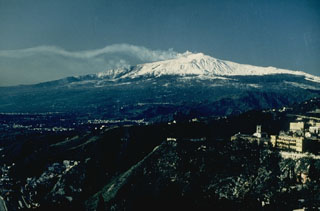Report on Etna (Italy) — 19 March-25 March 2025
Smithsonian Institution / US Geological Survey
Weekly Volcanic Activity Report, 19 March-25 March 2025
Managing Editor: Sally Sennert.
Please cite this report as:
Global Volcanism Program, 2025. Report on Etna (Italy) (Sennert, S, ed.). Weekly Volcanic Activity Report, 19 March-25 March 2025. Smithsonian Institution and US Geological Survey.
Etna
Italy
37.748°N, 14.999°E; summit elev. 3357 m
All times are local (unless otherwise noted)
The Sezione di Catania - Osservatorio Etneo (INGV) reported continuing activity at Etna during 17-23 March. Weather clouds often obscured views of the summit area, though during a few clear periods gas emissions were observed rising from the summit craters and Strombolian activity was observed at SE Crater. Strombolian activity at various vents in SE Crater began around 2225 on 19 March. Explosions ejected material a few tens of meters above the crater rim with coarse material falling back into the crater. The intensity and frequency of the explosions gradually increased until about 1430 on 20 March and material was ejected onto the flanks of the cone. The activity gradually decreased and by 1745 explosions were no longer visible in webcam images. Ash emissions that quickly dispersed near the summit persisted for around another hour. Strombolian activity at SE Crater was visible at 1125 on 24 March when weather conditions allowed for views, though it was not clear enough to determine the intensity and frequency of the explosions. At around 1235 lava overflowed the crater rim and traveled a short distance down the S flank. Strombolian activity continued until about 2100 on 24 March and around the same time the lava flow appeared to be cooling.
Geological Summary. Mount Etna, towering above Catania on the island of Sicily, has one of the world's longest documented records of volcanism, dating back to 1500 BCE. Historical lava flows of basaltic composition cover much of the surface of this massive volcano, whose edifice is the highest and most voluminous in Italy. The Mongibello stratovolcano, truncated by several small calderas, was constructed during the late Pleistocene and Holocene over an older shield volcano. The most prominent morphological feature of Etna is the Valle del Bove, a 5 x 10 km caldera open to the east. Two styles of eruptive activity typically occur, sometimes simultaneously. Persistent explosive eruptions, sometimes with minor lava emissions, take place from one or more summit craters. Flank vents, typically with higher effusion rates, are less frequently active and originate from fissures that open progressively downward from near the summit (usually accompanied by Strombolian eruptions at the upper end). Cinder cones are commonly constructed over the vents of lower-flank lava flows. Lava flows extend to the foot of the volcano on all sides and have reached the sea over a broad area on the SE flank.

